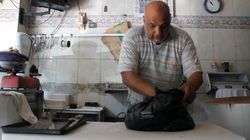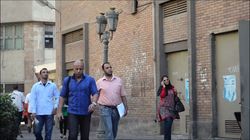Cairo|Egypt
Statistical Data
Google entries for Cairo + Cairo
+ al-Qahira + Le Caire + El Cairo 314790000
Google entries per inhabitant 37,75
POPULATION (2012)
City area 8.259.461 [1]
Greater Cairo Metropolitan Area 20.500000 [2]
[1] http://de.wikipedia.org/wiki/Kairo#cite_note-Bev.C3.B6lkerung_Stadt-3
[2] http://www.newgeography.com/content/002901-the-evolving-urban-form-cairo
Since there is no obligation to register in Egypt the population figures are projected from census results. Unofficial estimates, indicate more than 25 million inhabitants for the greater metropolitan area – nearly a third of Egypt’s entire population.
http://de.wikipedia.org/wiki/Kairo#cite_note-Bev.C3.B6lkerung_Stadt-3
45% of Egypt’s hospital beds, 92% of banks, 95% of embassies and consulates and 55% of private sector jobs are located in the conurbation of Cairo.
http://213.158.162.45/~egyptian/index.php?action=news&id=23430&title=No%20escape%20from%20traffic%20jams,%20pollution,%20noise%20in%20Egypt
Surface area
City 214 km²
Greater metropolitan area 5.360 km²
http://de.wikipedia.org/wiki/Kairo
Population density
City 38.595,6 inh./km²
Metropolitan area 3824,6 inh./km²
CLIMATE DATA
Max. temperatures Ø 27,7
Min. temperatures Ø 15,8
Rain fall / year (mm) 24,7
Days of rain 14,2
http://de.wikipedia.org/wiki/Kairo
POPULATION
Age Structure (Egypt; 2011 est.)
0-14 years 32.7% (male 13,725,282 / female 13,112,157)
15-64 years 62.8% (male 26,187,921 / female 25,353,947)
65 years and over 4.5% (male 1,669,313 / female 2,031,016) (2011 est.)
https://www.cia.gov/library/publications/the-world-factbook/geos/eg.html
Under 25 (2010) 52,3%
http://www.faz.net/aktuell/wirtschaft/vor-der-wahl-aegyptens-wirtschaft-liegt-am-boden-11543428.html
Religion
Sunni Moslems ca. 90%
Coptic Christians almost 10%
http://de.wikipedia.org/wiki/Kairo#Religionen
Literacy level (older than 10 and able to read and write)
Total 72%
Men 80.3%
Women 63.5% (2010 est.)
https://www.cia.gov/library/publications/the-world-factbook/geos/eg.html
Unemployment (Egypt)
Official unemployment rate 12,6% (1. Qu. 2012) [1]
Unemployment rate / city 16% (1. Qu. 2012) [1]
Unemployment rate under 30 years 35% [2]
Newly arriving workers / year 700.000 [3]
[1] http://english.ahram.org.eg/NewsContent/3/12/42241/Business/Economy/Egypt-Q-jobless-rate-climbs-to--per-cent-Statistic.aspx
[2] http://www.marketplace.org/topics/world/egypt-one-year/egypts-youth-await-jobs-revolution
[3] http://www.faz.net/aktuell/wirtschaft/vor-der-wahl-aegyptens-wirtschaft-liegt-am-boden-11543428.html
Only half of the 51 million Egyptians between the ages of 15 and 64 are counted in the government’s measure of the labour force, which is why the official unemployment rate stands at only 11%. If Egypt’s labour force were counted in the same way as America’s, the unemployment rate would be 40%. The effective unemployment rate is even higher, for three-fifths of Egyptians live on the land, while the country imports half its caloric consumption. Agricultural productivity in Egypt is so poor that most farm labour must be considered disguised unemployment. 30% of Egyptians of the relevant age moreover, attend university, while only half graduate, and of those, few find employment. Perhaps an additional 3 million Egyptian unemployed are warehoused in the university system.
http://www.atimes.com/atimes/Middle_East/MI20Ak01.html
TRAFFIC
Number of cars on Cairo’s streets (2010 est.) 14.000.000 [1]
Number of motor bikes 300.000 [2]
Costs of traffic jams in Cairo / year 8 billion US dollars [3]
Percentage of private traffic in traffic jams 70% [4]
Occupants / vehicle 1,3 persons [4]
[1] http://english.ahram.org.eg/NewsContentPrint/1/0/49611/Egypt/0/A-Guide--to-Egypts-Challenges-Saving-Cairo.aspx
[2] http://www.cnbc.com/id/44781282/World_s_Most_Polluted_Countries?slide=6
[3] http://www.worldbank.org/en/news/2012/08/21/cairo-traffic-much-more-than-nuisance
[4] http://www.egyptindependent.com/news/transport-hackathon-gathers-experts-solve-cairo-congestion
The actual rates of car ownership may be low, but the ratio of cars to km of road is one of the highest in the world.
http://www.worldbank.org/en/news/2012/08/21/cairo-traffic-much-more-than-nuisance
Traffic fatalities
Traffic fatalities in Cairo / year at least 1.000 [1]
Traffic fatalities je 100.000 registered vehicles (Egypt) 286 [2]
Traffic fatalities per 100.000 registered vehicles (OECD average) 13
[1] http://www.worldbank.org/en/news/2012/08/21/cairo-traffic-much-more-than-nuisance
[2] http://blogs.worldbank.org/transport/the-average-age-of-a-taxi-in-egypt-is-32-years-old#_ftn1
Age of vehicle fleet (Egypt)
70 % of all registered vehicles are older than 20 years.
More than 64.000 microbuses are older than 20 years
The average age of a typical Egyptian taxi is 32 years.
http://blogs.worldbank.org/transport/the-average-age-of-a-taxi-in-egypt-is-32-years-old#_ftn1
Public Transport
“Transportation has become more exhausting than work.”
http://www.nytimes.com/2012/05/04/world/middleeast/cairos-subway-is-efficient-orderly-and-dependable.html?_r=0
CTA (Cairo Transport Authority)
Employees 40.000
Buses 3.000
Passenger 3.5 million / day
http://onlinepubs.trb.org/onlinepubs/tcrp/tcrp_rrd_102.pdf
Bus lines 450
Railway network 8.460
http://de.wikipedia.org/wiki/Kairo#Verkehr
The Cairo Transport Authority runs two connected meter gauge railway nets in Cairo and Heliopolis. Since the takeover of the former independently working Heliopolis Company in 1991 all routes are under the CTA’s control. August 12, 1896 Cairo’s first tramline was opened, in Heliopolis it was September 5, 1908.
http://de.wikipedia.org/wiki/Cairo_Transport_Authority
Metro
Number of lines 3
Daily passengers 4 million
http://www.4-traders.com/VINCI-4725/news/VINCI-Opening-of-Phase-1-of-Line-3-of-the-Cairo-metro-14035130
In relation to its large and growing population, Cairo has a very small metro system. It is far smaller than the systems of other major cities, but much more crowded. Though it is half the size of the Washington DC metro, it carries four times more passengers per km of line.
http://www.worldbank.org/en/news/2012/08/21/cairo-traffic-much-more-than-nuisance
Tok-Toks or Rickshaws
Firstly imported to Egypt since 2005
Number of Tok-Toks in Egypt more than 500.000
Number of Tok-Tok drivers ca. 750.000
http://213.158.162.45/~egyptian/index.php?action=news&id=26776&title=Presidential%20boost%20for%20tok-tok%20drivers
"A tok-tok is like a lifeline for many unemployed young men. Most of these drivers are illiterate, which makes it very difficult for them to get any other job," says Souad Abdullah, a 59-year-old civil servant.
http://213.158.162.45/~egyptian/index.php?action=news&id=26776&title=Presidential%20boost%20for%20tok-tok%20drivers
POLLUTION
Air Pollution
Airborne particles per cubic meter
Cairo 138
Paris 38
New York 21
http://english.ahram.org.eg/NewsContent/1/0/49611/Egypt/Saving-Cairo.aspx
The Black Cloud
It appears only once a year, in September or October. And it is much more intense than the regular pollution, darkening the sky into a foreboding smog. The black cloud brings pollution levels up to ten times the limits set by the World Health Organization, and can persist for days or weeks at a time. The city lies in a valley surrounded by hills, which hold the poisoned air like water in a bowl. In the fall, frequent temperature inversions settle over Cairo—a weather phenomenon that occurs when a warmer, lighter air mass moves over a colder, denser air mass, trapping a layer of air close to the ground. The inversions still the winds, creating a stagnant soup of unmoving air. Meanwhile, an extremely dry climate means that cleansing rainstorms rarely appear. After rice husk burning was made illegal, farmers started burning it at night and early in the morning, when they are less likely to get caught. The fires now burn at the worst possible time for Cairo’s air. “The pollution reaches Cairo after sunset, which is just when the temperature inversion starts to form”.
http://earthdata.nasa.gov/featured-stories/featured-research/black-cloud-over-cairo
Noise Pollution
Average level of noise pollution in the city centre 90 decibels
Acceptable noise level 35-55 decibels
(EPA: U.S. Environmental Protection Agency)
http://english.ahram.org.eg/NewsContentPrint/1/0/49611/Egypt/0/A-Guide--to-Egypts-Challenges-Saving-Cairo.aspx
Garbage
Number of Zabbalees (independent garbage collectors) 120.000 [1]
Number of garbage in Cairo / daily 14.000 t [2]
Amount of garbage collected by Zabbalees / daily 8.000 t [2]
Recycling quota of the Zabbalees 80% [1]
http://globalrec.org/2012/02/23/egyptian-ngo-takes-major-step-towards-recognition-of-cairos-garbage-collectors/
http://hal-ens-lyon.archives-ouvertes.fr/docs/00/66/76/66/PDF/Editor_version-Special_Feature_2_Solid_waste_1_.pdf
LIVING COSTS (in Eur)
12 eggs 1.47,-
1 kg tomatoes 0.47,-
0,5 l Beer in a super market 0.8,-
1 l milk 0.98,-
Cleaning woman (1 hour) 3.07,-
Monthly rent for an 85 qm apartment
in an expensive neighbourhood 438,-
1 l petrol 0.24,-
Monthly ticket for public transport 12.66,-
Cab drive (8 Km) 2.83,-
http://www.expatistan.com
ECONOMY
From early on Cairo was an important centre of commerce due to its easy accessible position as a turntable between Southern Europe, the Orient and Black Africa. The most important branches of production are the metal processing, the cement industry, furniture, shoe, tobacco and textile production as well as the printing industry. As the most important commercial centre of the Middle East Cairo is the headquarter of numerous companies and economical organisations. The city’s biggest commercial sector is the public sector, including the government, the public institutions and the military. In addition to this tourism plays an important role. Cairo is Egypt’s touristic centre and it’s biggest source of foreign exchange revenue. A third of all of Egypt’s industrial companies are based in the Cairo area. The city is also the most important publishing centre.
http://de.wikipedia.org/wiki/Kairo#Wirtschaft_und_Infrastruktur
Economic rankings
Cairo GDP (Gross domestic product)
2008 145 billion USD
2025 330 billion USD
https://www.ukmediacentre.pwc.com/imagelibrary/downloadMedia.ashx?MediaDetailsID=1562
Approximately two-thirds of Egypt’s gross domestic product GDP is attributable to the Cairo metropolitan area.
http://onlinepubs.trb.org/onlinepubs/tcrp/tcrp_rrd_102.pdf
Black Economy in Egypt
Informal sectors (2007) ca. 33% of the GDP
http://www.fundresearch.de/sites/default/files/partnercenter/axa-investment-managers/Marktkommentar%20von%20AXA%20Investment%20Managers_Vom%20arabischen%20Fr%C3%BChling%20zur%20arabischen%20Wiedergeburt.pdf
Part oft he economy controlled by the military 15-40%
(Estimation)
http://www.aljazeera.com/indepth/features/2012/02/2012215195912519142.html
Income per head 4.776,-
(Egypt, in Euro, 2010)
http://www.faz.net/aktuell/wirtschaft/vor-der-wahl-aegyptens-wirtschaft-liegt-am-boden-11543428.html
Poverty line in Egypt
Poverty line less than 1,3 EUR / Tag [1]
Population below the poverty line 25,2%
Extreme poverty less than 87 cent
Extremely poor part of the population 4,8%
http://www.egyptindependent.com/news/govt-poverty-rate-increased-252-percent-population
Around 65 out of 82 Million Egyptians today still have ration coupons with which they can get sugar, oil and rice, at reduced prices.
http://m.ftd.de/artikel/70069002.xml
US aids (2010)
Economic aid
Egypt 250 million
Israel 400 million
Military aid
Egypt 1.300 million
Israel 2.775 million
Total
Egypt 1.550 million
Israel 3.175 million
http://www.vaughns-1-pagers.com/politics/us-foreign-aid.htm
Following the peace treaty with Israel, between 1979 and 2003 the US has provided Egypt with about $19 billion in military aid, making Egypt the second largest non-NATO recipient of US military aid after Israel. Also, Egypt received about $30 billion in economic aid within the same time frame.
http://en.wikipedia.org/wiki/Foreign_relations_of_Egypt#United_States
Informal (illegal) housing development
In total, 65 % of urban population live in what is considered informal housing.
http://workshopsariyer.files.wordpress.com/2011/04/2-konf-2-oturum-dina-shehayeb-informal-housing-in-cairo-an-overview.pdf
“The majority of the urban growth is happening in the informal areas of the city and not in the formal or planned areas,” says Abdelhalim. This is largely due to the fact that the government did not offer reasonably priced land that can boast the growth of lower-income housing. With no influx of formally planned homes for a growing population, informality became the only alternative.
http://www.businesstodayegypt.com/news/display/article/artId:367/The-Informal-Sprawl/secId:5
Bread subsidies (figures in billion EUR, national budget for 2012/13)
National budget 67,46 [1]
therefrom subsidies 18,45 [2]
therefrom food subsidies 3,37 [2]
therefrom bread subsidies 2,03 [2] other sources 2,73 [5]
Bread subsidies in 2011/12 1,37 [2]
Weight of a loaf of bread (eish baladi) ca. 140 g [5]
Number of subsidised loaves of bread / day 250 million [2]
State-funded subsidised bakery’s 20.000 [3]
Price per bread 5 Piaster = 0,65 Eurocent [3]
Scheduled price rise 10 Piaster = 1,3 Eurocents [5]
Subsidy per loaf of bread 24 Pisaster = 3,12 Eurocent [2]
Wheat consumption (2012) 18,8 million t [4]
therefrom imported wheat 9 million t [4]
Fatalities at the so-called bread riots 1977 79 [6]
[1] http://www.sis.gov.eg/En/Story.aspx?sid=64423
[2] http://english.ahram.org.eg/News/50588.aspx
[3] http://www.aljazeera.com/indepth/opinion/2012/03/201237104725536741.html
[4] http://www.taipeitimes.com/News/biz/archives/2012/10/07/2003544550
[5] http://dailynewsegypt.com/2012/08/28/minister-of-supply-seeks-ways-to-sustain-bread-subsidies/
[6] http://www.nzz.ch/aktuell/wirtschaft/wirtschaftsnachrichten/aegyptens-subventionen-strangulieren-den-staatshaushalt-1.17411807
Subsidies
Share of Subsidies percentage of the GDP more than 10% [1]
Share of Subsidies percentage of the national income ($79 billion) 28% [2]
Subsidies’ share of the price of oil, gas and electricity 55,6% [3]
[1] http://www.faz.net/aktuell/wirtschaft/vor-der-wahl-aegyptens-wirtschaft-liegt-am-boden-11543428.html
[2] http://online.wsj.com/article/SB10001424052970204059804577228984285910816.html
[3] http://m.ftd.de/artikel/70069002.xml




















